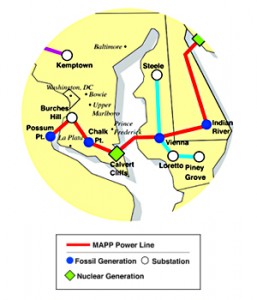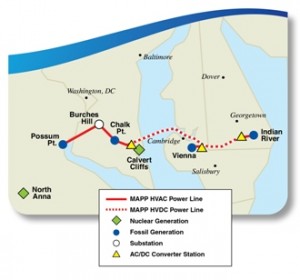MAPP transmission delayed… REALLY delayed…
August 19th, 2011
 Slowly but surely, Delmarva Power/PEPCO is admitting the Mid-Atlantic Power Pathway (MAPP) isn’t needed. We’ve weathered the weather, and they’re not even utilizing demand response, so where’s the need? They’ve delayed this project, shortened it when they cut out the part through Delaware from Indian River Power Plant to the Salem nuclear plant, delayed and delayed, and now they’re REALLY delaying it, putting it off until at least 2019-2021.
Slowly but surely, Delmarva Power/PEPCO is admitting the Mid-Atlantic Power Pathway (MAPP) isn’t needed. We’ve weathered the weather, and they’re not even utilizing demand response, so where’s the need? They’ve delayed this project, shortened it when they cut out the part through Delaware from Indian River Power Plant to the Salem nuclear plant, delayed and delayed, and now they’re REALLY delaying it, putting it off until at least 2019-2021.
Remember how the sky would fall and we’d be sweltering in the dark on a respirator without a job if this didn’t go through right away? Well, guess again, and again, and again… the system is just fine, we can turn the lights on, we’re OK, and this line still isn’t needed and won’t be, probably ever!
From MAPP’s corporate parent, PEPCO Holdings Inc.:
As the Environmental Coordinator for the Mid-Atlantic Power Pathway (MAPP), I want to provide you with a brief update on the project.
As you may recall, MAPP is a proposed, high-voltage, electric transmission line that Pepco Holdings, Inc. (PHI) plans to build, beginning in northern Virginia, crossing the southern and eastern shores of Maryland, and ending in Delaware.
I want you to know that PHI has notified the Maryland Public Service Commission and Virginia State Corporation Commission that the company is requesting temporary delays in the Commissions’ reviews of the respective applications filed by the utility’s subsidiaries, Pepco and Delmarva Power, for state regulatory approval of MAPP. These requests were filed after PJM Interconnection’s recent analyses indicated that the MAPP in-service date should be moved from 2015 to the 2019-2021 time frame. (PJM is the operator of the regional electric power grid).
However, PJM is also currently evaluating the criteria it uses to determine the need for transmission projects. Once this process is completed, PJM will reassess the need and timeline for transmission expansion in the region.
At this time, PHI will review the work required to support MAPP based on the new in-service date, and will keep you informed on subsequent developments regarding this project.
Please be assured that PHI and PJM are dedicated to maintaining the reliability of this region’s transmission system, and will continue to analyze the need for new transmission projects that provide safe and reliable service for customers.
For additional information about MAPP, please visit the project website at www.powerpathway.com or contact me via phone at 302-283-6115 or e-mail at mark.okonowicz@pepcoholdings.com.
Also, members of our MAPP team would be happy to meet with you in person to discuss the project. Please let me know if you would like to have a meeting scheduled.
Sincerely,
Mark Okonowicz
MAPP – Environmental Coordinator
There a link on the Press Release to a PJM letter:
The MAPP transmission project is needing a DOE EIS because they’re getting DOE funding for it. What’s the status on that? D-E-L-A-Y… delay delay delay…
The MAPP EIS doesn’t seem to be happening… The DOE site says that it was to be released next month, or maybe December, but rumor has it that the DOE is waiting on info from the applicants… delay delay delay… and in the meantime, the DOE is still accepting (sounds like REQUESTING) Comments:
Community and Environmental Defense Services states that: While the Scoping comment period ended April 4, 2011, DOE will continue accepting comments, which should be directed to:
Douglas Boren
Office of NEPA Policy and Compliance (GC–54)
U.S. Department of Energy
1000 Independence Avenue, SW.,
Washington, DC 20585
Douglas.Boren@hq.doe.gov
Fax: 202–586–7031
202–287–5346
Again, contact info if you’d like to send a “Thank You” note of appreciation to Mark Okonowicz and PEPCO for admitting what we’ve all known all along, that this MAPP transmission line is not needed:
302-283-6115
or
mark.okonowicz@pepcoholdings.com
PEPCO is falling down on the job
December 12th, 2010
Nearly two years ago, I attended a hearing for the Delmarva Power Integrated Resource Plan, which was the most bizarre hearing I’ve ever experienced. At that time, I raised issues about decreasing demand, entered into the record the PJM demand documents that we’d used in the Susquehanna-Roseland transmission docket in New Jersey (also PJM), and raised concerns that no SAIDI, SAIFI and CAIDI reliability info was reported. After that meeting, I presented Delmarva Power’s attorney Todd Goodman with a well-deserved “Horse’s Ass” award for his performance at that meeting. The points I’d raised at that meeting about what was missing in their “IRP” were oh-so-valid:
It took a while, but last week, the Washington Post featured an article showing that PEPCO, utility in D.C. and Maryland, and the corporate parent of Delmarva Power, has an inexcusably miserable record for outages. That’s something that’s demonstrated in the SAIDI, SAIFI and CAIDI reports! And folks, don’t go conflating transmission with distribution as the cause for the outages, as utilities would have you do. Anyway, here’s that article:
Washington Post Analysis: Why PEPCO can’t keep the lights on
As you read the article, note there’s not a word on D-E-R-E-G-U-L-A-T-I-O-N as a contributory factor, much less the primary reason.
Washington Post analysis: Why Pepco can’t keep the lights on
Moreover, Pepco has long blamed trees as a primary culprit for the frequency and duration of its outages, implying that the problem is beyond its control. But that explanation does not hold up under scrutiny, The Post analysis found. By far, Pepco equipment failures, not trees, caused the most sustained power interruptions last year.
Read the rest of this entry »
MAPP application filed in Maryland
November 17th, 2010
I got word a couple days ago that the MAPP transmission line, Mid-Atlantic Power Pathway (not Mid-Continent Area Power Pool) application has been filed in Maryland.
Here is the Maryland Public Service Commission page for this project.
The Sierra Club has been on the front lines fighting MAPP. Here’s the SIERRA CLUB MAPP & PATH PAGE.
This is Travis Miller/Morningstar’s take on PEPCO and MAPP:
Here’s PEPCO’s 3Q 2010 Financial Results.
Why isn’t this application reported anywhere? Well, anywhere that google picks up?
PEPCO is Zack’s “Bear of the Day!”
June 30th, 2010
(Just looking for an excuse to trot out that pole-dancing bear!)
BEAR ALERT!!! Couldn’t happen to a more deserving company — Google Alert just sent me notice that one of my “favorite” companies is Zack’s “Bear of the Day!” Why? Well, they specifically mention that MAPP transmission project that just doesn’t seem to be needed:
Bear Of The Day: Pepco Holdings, Inc. (POM)
Check out their individual reports for other utilities and industries. Let’s hear it for the capital market crash — ain’t the depression grand?!?!?!
How bad is it? First the Indian River to Salem leg is cancelled, then the whole thing is suspended… and here we sit… waiting… and we all know that PJM demand is down the toilet.
Click here for the last RTEP Mid-Atlantic subcommittee presentation — see if you can download it!
And they opened an office and now they announce:
Meanwhile, we wait for the RTEP that just won’t come out. How delayed can it get? I guess all that backwards engineering to demonstrate need takes a while, eh?
PJM & PEPCO’s MAPP line trying to appease
May 9th, 2010
The MAPP line, PEPCO’s Mid-Atlantic Power Pathway transmission line project through Maryland and Delaware, is in the news again. But why??? Where the line is not needed, and it’s withdrawn by PJM and PEPCO, why is this being accepted? Why is this regarded as a “win?”
Remember that they pulled the project?
PEPCO letter 1.8.09 to suspend MAPP, includes 1.8.09 letter from PJM’s Herling
And before that, the part from Indian River to Salem was eliminated?
The May, 2009, Press Release says:
According to Gausman, PJM has also reviewed the need for the section of the line that would run from Delmarva Power’s Indian River substation near Millsboro, Del., to Salem, N.J., and has decided to move this portion of the line into its “continuing study” category. This means that the reconfigured MAPP line will now extend approximately 150 miles from northern Virginia, across southern Maryland and the Chesapeake Bay, and terminate at Indian River. The change would likely reduce the total project cost from $1.4 billion to $1.2 billion.
And then there’s the report that shows there’s no need, that demand is downdowndown, that “congestion” is downdowndown, that price of electricity is downdowndown, that demonstrates that the market concept that they’re all drooling over will have them aspirating their aspirations:
So then why did they send out a press release last week:
…which every Peninsula news outlet gave pretty much verbatim coverage?
And then there’s the PJM RTEP 2009, released February 26, 2010.
So here’s how their press release looks after the papers get it:
Delaware utilities: Plan takes power line under Choptank
It is being planned by Pepco Holdings Inc., parent company of Delmarva.
Now read the other “articles” and tell me if there’s an echo in the room:
Underwater power line route suggested
Proposal under Chesapeake avoids refuge
By Calum McKinney • Staff Writer • May 6, 2010
But the day before it was better, with some original quotes:


